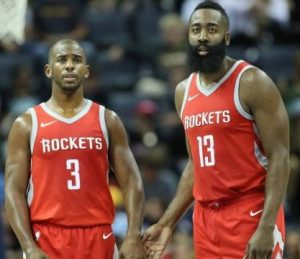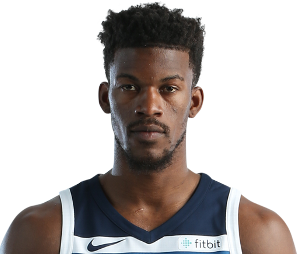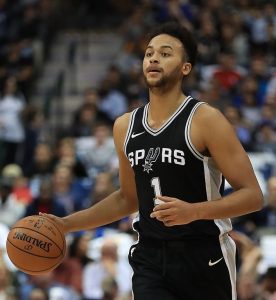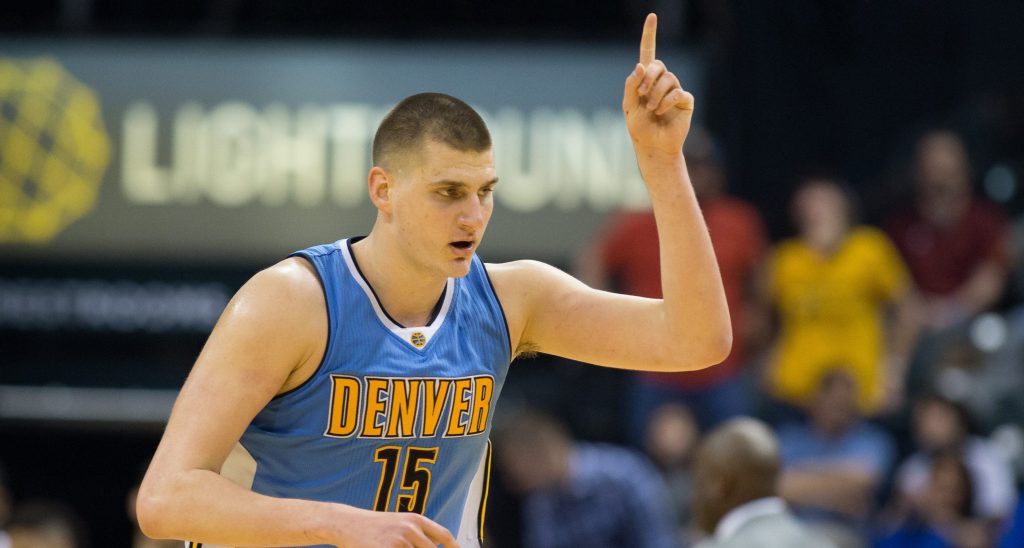 Brandon Jennings made his 2018 debut with the Bucks in Memphis Monday night and was so energized he hauled in 8 rebounds and nearly pulled off a triple double (he had 13 pts and 12 asts to go with the boards). It was enough to raise the question of why Jennings — whom the Bucks signed to a 10-day contract March 11 — wasn’t signed earlier, or at least on March 1 when the Bucks instead picked up all-offense/no-defense T-Wolves forward Shabazz Muhammad off the waiver wire.
Brandon Jennings made his 2018 debut with the Bucks in Memphis Monday night and was so energized he hauled in 8 rebounds and nearly pulled off a triple double (he had 13 pts and 12 asts to go with the boards). It was enough to raise the question of why Jennings — whom the Bucks signed to a 10-day contract March 11 — wasn’t signed earlier, or at least on March 1 when the Bucks instead picked up all-offense/no-defense T-Wolves forward Shabazz Muhammad off the waiver wire.
The Bucks have been playing without injured Bucks point guards Malcolm Brogdon and Matthew Dellavedova since Feb. 4 when Delly wrecked his ankle in Brooklyn, with no guarantee either player will be able to get back into game shape for the playoffs. After beating up on a string of lottery bound teams before the All-Star break, the Bucks lost 7 out of 10 games between Feb. 15 and a March 9 win vs. the Knicks (the last game before the roster moves over the weekend). Jennings, veteran point guard fresh off a season in the Chinese Basketball League with excess zip in his tank, might’ve helped. No – there’s no doubt Jennings would have helped. Eric Bledsoe was the last point guard standing on the roster, and the Bucks tried to use two-way player Xavier Munford and even gunner Sean Kilpatrick at point.

It seems unlikely that anything Shabazz Muhammad does for the Bucks will effect the rest of their season. Zimbio photo. License: Standard non-commercial use.
By waiting until this week the Bucks not only kept losing, but had no more disposable contracts/players to clear out a roster spot for Jennings. The one they had, Sean Kilpatrick, was waived to bring in Muhammad. So they opted to cut a player whose $10.5 million contract is anything but disposable.
The victim was Mirza Teletovic, still recovering from pulmonary embolism (blood clotting) in both of his lungs, which developed after Teletovic underwent arthroscopic knee surgery Nov. 21. The Bucks reported Mirza’s condition Dec. 14, saying “updates on his condition will be provided when appropriate.”
Three months went by and no updates were forthcoming until last Saturday when Bucks requested waivers on Teletovic. “The Bucks and Mirza Teletovic, in consultation with team doctors and other physicians, have been working together since December to evaluate and manage Mirza’s situation,” said Bucks GM Jon Horst in a press release. “As a result of the overall evaluation that we’ve gone through, at this time we are both moving on.”
Apparently that’s the update. And apparently the Bucks and Mirza were not “working together” so well. Teletovic had been silent since the injury and hadn’t posted a tweet to his twitter account since September — until the afternoon of Feb. 28, when he denied statements by Racine Journal Times’ Gery Woelfel, who said on 105.7 The Fan radio that his sources told him “Mirza Teletovic’s career is over.”
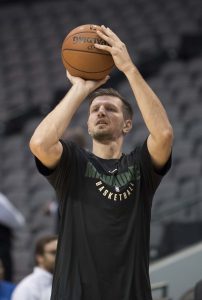
Mirza Teletovic, warming up before a game earlier this season. NBA photo. License: Standard non-commercial use.
Of course it was Woelfel, of course his source (s) weren’t named and of course it wasn’t true. Later that afternoon, Teletovic denied it, tweeting that “it’s not over until I say it’s over recovery is going great”, punctuated by three smileys, all of them winking an eye. When asked specifically (on twitter) whether the report about his career being over was true, he said “No it is not, my friend.”
Ten days later and here we are: Teletovic waived, Muhammad signed for the rest of the season, and Jennings back to work in Milwaukee on a 10-day contract. Nobody lied, not Horst, not Woelfel, not Teletovic — “it was just . . . bullshit”, to paraphrase Blues Brother Elwood J. Blues. Winking, smiley bullshit. Mirza and the Bucks were not on the same page about his rehab or future plans — Mirza wants to play, wink wink; the Bucks hope he can’t play and that the NBA grants them a “Disabled Player” waiver next season. The Bucks will still have to pay Teletovic his guaranteed 2018-19 salary of $10.5 million, but with a medical waiver it won’t count as part of the Bucks “Team Salary” calculation.
The NBA medical waiver: How to get one and what it means to the Bucks
Part of the medical waiver process is to waive the injured player, according to the NBA Collective Bargaining agreement (Article VII, Section 4 (h) on “Long Term Injuries”). The Bucks did that March 10. The next step is to apply for the waiver and then wait until Nov. 7, the one year anniversary of the last day Mirza played for the Bucks. The process is to either leave the determination to a doctor the NBA and the Players’ Union agree upon (which seems unlikely given the Bucks and Mirza’s disagreement about his ability to play) or go to a panel of three physicians, one for the player (union), one for the NBA and a 3rd doctor the other two agree upon (Article XXII, Sec. 11, CBA). The panel would then decide whether Mirza’s career is over. If the determination goes against him, he can appeal after nine months if his condition changes.
If he is cleared to play, his $10.5 million contract goes on the Team Salary ledger and the Bucks will pay luxury tax to have a roster, one way or another. Frank Madden, founder of Brewhoop, posted the following chart on twitter after the Bucks waived Mirza.
Updated look at Bucks projected 18/19 cap obligations *if* the NBA granted a medical retirement waiver for Teletovic. Note that this can't officially happen before November, so Jabari's future would presumably be decided much earlier. pic.twitter.com/EWgmI1Pu6w
— Frank (@fmaddenNBA) March 11, 2018
The $20.3 million assigned to Jabari Parker is not what he’ll be paid next season (that amount is unknown) but is the restricted free agent (RFA) cap hold Parker represents, which draws the Bucks to $7.6 million under the luxury tax for 11 players (they’re required to have 14 but CBA rules encourage teams to maintain a full 15-man roster). Mirza’s $10.5m + the low estimate for Parker puts the Bucks in the luxury tax zone, where, as a first time offender, they would pay $1 to the NBA for every $1 they’re over the luxury threshold. Without the waiver, the Bucks would pay a total of about $140 million or more for a roster that has yet to win a playoff series (barring any possible trades to improve the situation).
With the waiver, the Bucks could comfortably sign Parker, keep Tyler Zeller (not guaranteed for next season) and maintain a 15-man roster at or under the luxury tax threshold. They’d still pay Teletovic $10.5, putting next year’s actual payroll over $130 million — but it wouldn’t cost them an additional $8-10 million in league taxes. Mirza’s desire to play, and the real possibility that he and the Players’ Union will challenge the Bucks medical waiver request, could become a double-whammy for the Bucks.
Replacing Ilyasova
The irony here is that Mirza was signed as a result of the Bucks projecting a player-friendly pose in their personnel decisions. Mirza’s value is in the role of stretch-4 forward capable of going on devastating 3-point hot streaks off the bench. That job was filled in Milwaukee until 2015 by veteran Ersan Ilyasova (who often started) but the Bucks also had Giannis Antetokounmpo and Parker (coming back from his first knee surgery) at power forward — there wasn’t going to be much playing time for Ersan, not the 27 mpg he was used to getting. So the Bucks traded him to Detroit for basically nothing (soon-to-retire Caron Butler and forward Shawne Williams), the idea being that Ilyasova would start at power forward for the Pistons, which he did.
After the Bucks floundered to a 33-win season, coach Jason Kidd and GM John Hammond decided they needed more 3-point shooting, and that, while they had done the right thing finding Ersan a new home, it was time to fill the stretch-4 void created by the trade with Detroit. Mirza had played for Kidd in Brooklyn, coming off the bench to gun threes behind Paul Pierce. He had put up some good shooting numbers in Phoenix in 2016, and was a client of Jeff Schwartz, who, as it happens, also represents Kidd on the speaking engagement circuit (and was probably Gery Woelfel’s source, given his rumor-mongering this season about Schwartz’s new client, DeAndre Jordan).
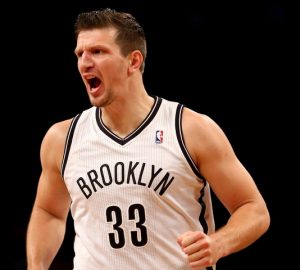
Mirza played for Jason Kidd in 2013-14, the season prior to Kidd taking the job as Bucks coach. Getty Images 2015. License: Standard non-commercial use.
Mirza signed a 3-year-$31.5 million contract, a bigger haul than the 2yrs-$16.3 million Ersan had left on his contract when the Bucks traded him, but that was water under the bridge, and well, the new TV deal was expected to create a lot of salary cap space to operate under, no reason to sweat the details. Unfortunately, when Mirza arrived, it was quickly discovered that all he could do was shoot threes, and was a liability in other facets of the game. He had, in fact, been Jon Leuer‘s backup in Phoenix after the Suns benched Markieff Morris, then saw his playing time pick up when Leuer went cold from the field and succumbed to nagging injuries. Kidd and Hammond (and current GM Horst, then Hammond’s right-hand man) had guaranteed Jon Leuer’s backup $10.5 million a year for three years.
Teletovic had his moments that first season with the Bucks — Nov. 5 against the Kings in Milwaukee, where he shot 7 for 9 from three and poured in 22 points in 20 minutes in a Bucks blowout win; a game in Washington Dec. 10, where Mirza’s shooting (25 pts, 5 of 6 from three) helped stake the Bucks to a 6-point lead in the 4th, only to see the Wizards dominate the Bucks starters in the final minutes. He scored 19 pts in 16 mins in Indiana Feb. 11 as the Bucks began to pull together after Parker was lost for the season. But those games were few and far between. After the win vs. the Pacers, Teletovic would score only 8 points over the next 8 games, going scoreless in four of those. He played just 26 mins in the 6-game playoff series against Toronto. No power forward in the NBA had played as much (1133 mins) during the 2016-17 regular season and put up worse all around numbers — his BIER was -0.57, far, far below the median for NBA forwards. (see post on the basics of BIER).
The Bucks hardly noticed Teletovic’s struggles as they won 20 of their last 30, in large part because they had found another forward in the summer of 2016 — Michael Beasley, whose career was languishing in Houston; and the Rockets were gracious enough to let Beasley go to the Bucks for the price of little-used Tyler Ennis. The Bease was instant offense off the Bucks bench last season, shooting 53% from the field and 42% from three, posting a BIER of 7.97, 12th best (per 36) among NBA small forwards.
Schwartz had taken Kidd, Hammond (and Horst) to the cleaners on the Teletovic deal, that much was clear, and the ramifications hit home in year 2 of his contract. With $10.5 million due Mirza this season, the Bucks had no money to sign Beasley, who went to the Knicks for $2.1 million. This left Mirza as the only non-rookie forward on the Bucks bench while Parker rehabbed his knee. He was simply going to have to play better this season, and to that effect he had laser surgery in the offseason to correct his vision. For 10 games, he actually was better, making 21 of 45 threes (47%). But Mirza is 32 years old, and it was too little, little too late.
Mirza’s NBA career was all but over after last season — and should have been — yet neither he nor the Bucks were in a position to admit it, not with two years and $21 million in guaranteed money still left to be paid.
The hindsight realizations about how bad the Teletovic contract was for the Bucks came crashing down again when the cartilage in his left knee went bad and it was announced he would undergo more surgery and miss at least four weeks.
Post-surgery pulmonary embolism is not uncommon, according to the Mayo Clinic, and can be life threatening if not diagnosed. Mirza’s was diagnosed. Embolism occurs when a body is immobile, seated for long hours of travel or bed-ridden after surgery. The blood clots form in the main artery running from the legs to the heart, then settle to form blockages in the heart and lungs. Blood thinners and rest are the common treatment, plus lots of water and mobility, according to the Mayo Clinic guide; and the clots usually break up and go away. Mirza says he’s coming along just fine, and hopefully he is.
None of which may have anything to do with whether or not Mirza can play next season. In letting him go, the Bucks relieved him of a job he was only able to perform for the Bucks every so often when healthy. Now that the Bucks job is gone, is there another NBA job out there for him? Mirza will be 33 years old when doctors decide in November whether his injury and illness were career ending.
The Bucks will probably get their medical waiver, and will have dodged another Team Salary bullet. Teams are usually granted such exceptions (as the Miami Heat were this season for Chris Bosh, also recovering from pulmonary embolism, though under different circumstances — the Heat wanted Bosh back and tried to get him cleared to play).
Mirza will collect his guaranteed $10.5 million and try to play again at some point, somewhere. Or maybe not (smiley smiley, wink wink). Whatever happens in November, nothing Jon Horst did last weekend is helping the Bucks tonight against the lowly Magic in Orlando.
Sourcerole:
- Bucks news, official press releases – http://www.nba.com/bucks/news/
- Mayo clinic on pulmonary embolism – https://www.mayoclinic.org/diseases-conditions/pulmonary-embolism/diagnosis-treatment/drc-20354653
- NBA Collective Bargaining Agreement (CBA) – https://ak-static.cms.nba.com/wp-content/uploads/sites/4/2017/10/2017-NBA-Collective-Bargaining-Agreement.pdf


